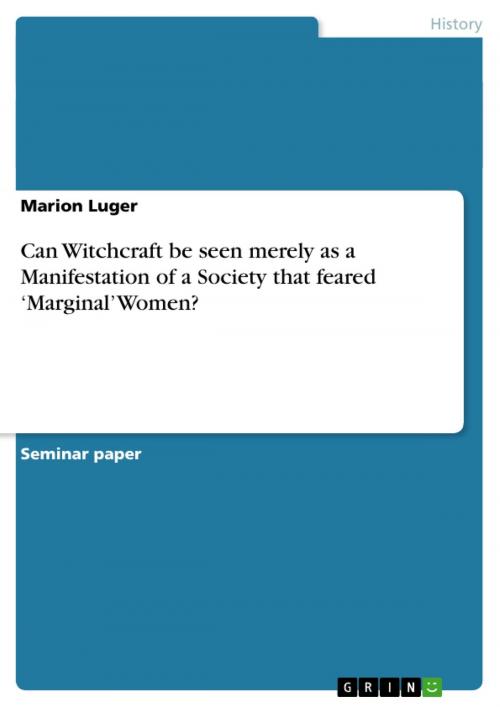Can Witchcraft be seen merely as a Manifestation of a Society that feared 'Marginal' Women?
Nonfiction, History, European General| Author: | Marion Luger | ISBN: | 9783640427734 |
| Publisher: | GRIN Publishing | Publication: | September 15, 2009 |
| Imprint: | GRIN Publishing | Language: | English |
| Author: | Marion Luger |
| ISBN: | 9783640427734 |
| Publisher: | GRIN Publishing |
| Publication: | September 15, 2009 |
| Imprint: | GRIN Publishing |
| Language: | English |
Seminar paper from the year 2000 in the subject History Europe - Other Countries - Middle Ages, Early Modern Age, grade: 1,0, University of Sussex, language: English, abstract: Beginning in the 14th century, witchcraft-persecution in Europe reached its peak in the 16th and 17th centuries and gradually ended in the 18th century. Apart from this broad local and temporal framework, in the Historic sciences several elements of uncertainty still exist. For instance, the number of accused people varies from over 100,000 to a million, and their geographical and chronological distribution was extremely uneven. Moreover, the phenomenon of witchcraft can hardly ever be linked with a specific group of society, as 'it involved both the educated classes and the common people'. In this essay, however, we will firstly consider the appreciation of witchcraft by the elite as well as by the populace (section II). Thereupon, section III describes the preconditions for and the functions of witchcraft-beliefs. Then, section IV shows the interaction of traditional popular sentiments and contemporary authoritarian views and its results. Finally, section V. examines the causes for the transformation from a 'private' handling of witchcraft to formal accusations, the affected people and the expansion of their number.
Seminar paper from the year 2000 in the subject History Europe - Other Countries - Middle Ages, Early Modern Age, grade: 1,0, University of Sussex, language: English, abstract: Beginning in the 14th century, witchcraft-persecution in Europe reached its peak in the 16th and 17th centuries and gradually ended in the 18th century. Apart from this broad local and temporal framework, in the Historic sciences several elements of uncertainty still exist. For instance, the number of accused people varies from over 100,000 to a million, and their geographical and chronological distribution was extremely uneven. Moreover, the phenomenon of witchcraft can hardly ever be linked with a specific group of society, as 'it involved both the educated classes and the common people'. In this essay, however, we will firstly consider the appreciation of witchcraft by the elite as well as by the populace (section II). Thereupon, section III describes the preconditions for and the functions of witchcraft-beliefs. Then, section IV shows the interaction of traditional popular sentiments and contemporary authoritarian views and its results. Finally, section V. examines the causes for the transformation from a 'private' handling of witchcraft to formal accusations, the affected people and the expansion of their number.















